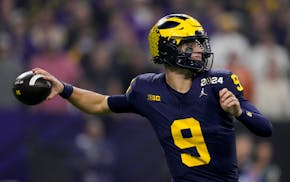Asked this week whether he has lost his team, Brad Childress said, "I don't even know what that means."
He should. He's lost a team before. So have his predecessors and peers.
At the end of his rookie season as an NFL head coach in 2006, Childress released receiver Marcus Robinson on Christmas Eve, shortly after Robinson questioned Childress' offensive scheme. Childress, acting out of anger, made himself look small and vindictive and lost what little support he had in the locker room at that time.
In their next game, the Vikings lost to a bad Rams team that came into the game at 7-8 by a score of 41-21. The Vikings had not allowed more than 31 points in any other game that season.
It was obvious Childress had lost that team. This is not a rare occurrence in the NFL, where coaches ask their players to deliver and absorb brutal hits that could shorten careers already filled with uncertainty.
More than in any other mainstream sport, football players have to believe in their coach and their cause to play their best.
As the football philosopher Brett Favre put it this week, "Ultimately, regardless of scheme, philosophy ... the bottom line is you are playing for yourself first. If you don't play well, you may be out of the league before too long. Second, you are playing for your team."
This week, Childress released another problematic receiver who had just criticized him. This time, the receiver was a future Hall of Famer who cost the Vikings a third-round draft pick and $1.5 million in salary for an unproductive month.
Randy Moss was a like a stink bomb in the Vikings locker room. You can remove the device; the odor remains.
Childress was right to release Moss, even if that move pointed out the mistake the Vikings had made in acquiring him, but the smell of divisiveness lingers.
Moss won over some of his teammates, including Percy Harvin, perhaps the Vikings' most pivotal offensive player.
Now Childress commands a locker room led by Favre, no fan of the coach, and Harvin, and the player who has always spoken most highly of Childress -- Pat Williams -- is reaching the end of his effectiveness.
This is a bad time to be Brad Childress.
If the last game of the 2006 season didn't prove to him that a coach can lose his team, let's summon an instructive moment in Vikings history.
Before the 1990 season, Jerry Burns' records as Vikings head coach was 38-25. He took the '87 team to the NFC title game. He was a lovable character who seemed to have the affection of his key players.
Then, in 1990, the Vikings finished 6-10. In '91 they were 8-7 entering the last game of the season but out of playoff contention. The Vikings faced Green Bay at the Metrodome. The Packers were 3-12, and their coach, Lindy Infante, was about to get fired.
The lousy Packers and their lame-duck coach won 27-7. Jerry Burns was fired and replaced by Dennis Green. Burns was still a likeable character with a wealth of football knowledge, but when he lost his team, he lost his job.
Even the greatest modern-day coach, Bill Belichick, lost a team. Belichick, now known for getting the most out of his players, was then known for the paranoia and openly feuding with local legend Bernie Kosar in much the same way Childress feuded with Moss. Like Moss, Kosar was released to the dismay of the team's fans.
Belichick's record in Cleveland: 36-44 overall, 5-11 his last year.
Sunday, Childress will find out what he has wrought by clashing with Favre, and releasing Moss, and failing to take command of a talented team this season.
Sunday, his team plays a game it desperately needs to win against an inept opponent at Mall of America Field.
If the Vikings do win, their next two games -- at Chicago and at home against Green Bay -- could turn around their season.
But only if Childress can find a way to lead, and his players choose to follow.
Jim Souhan can be heard Sundays from 10 a.m. to noon and weekdays at 2:40 p.m. on 1500ESPN. His Twitter name is Souhanstrib. • jsouhan@startribune.com

Souhan: Wolves fans made Game 1 special. Now bring on Game 2.

Souhan: Should Vikings even consider McCarthy in NFL draft?

Souhan: NAW erases Suns' lead, Game 1 advantage with big performance

Souhan: This is KAT's chance to prove Flip Saunders was right


